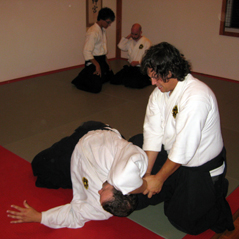|
When the Teacher is Absent
|
Fujiyama Dojo P.O. Box 20003 Thorold, ON, Canada L2V 5B3 (905) 680-6389 |
|---|
 The structure of a dojo is known to all students. The shomen, or main wall, is the place of the kamidana and photos of the founders. At the left is the joseki, at the right the shimonoseki.
The basic etiquette is also common knowledge. Once the dojo has formalized sempai participation and the conventional structure is guaranteed according to attendance, dedication and level of skill, all of the above is enforced. Not before. Hence, the sempai's role becomes the backbone of the dojo in relation to the kohai.
It is the sempai who begins the jumbi undo and prepares the deshi for the start of the class. It is the sempai who, once the techniques are given by the sensei, carries out the commands given and makes sure the discipline is kept. Without complete sempai participation the class is considered to be informal. The Shomen or Kamiza is not truly honored until the whole structure is adequately in place. No exceptions are allowed. The dojo is, after all, the place of the WAY. It is an absolute. To establish it with any less would be shameful.
The sempai structure makes all what it is meant to be. The Sensei points the way and instructs. The sempai's duty is to enforce the teachings with help and example; not just of technique, but also of conduct. Thus, the reflection of a good dojo is most obvious when the teacher is absent. The students are then free to act and train. But the guidance of the sempai still remains the key to what happens around and on the tatami. It is when the teacher is not in class that the true nature of the dojo comes through. Poor-spirited students use the teacher's absence as an excuse not to come to practice. Others use it to act stupidly in class. If this is the case, not much of the might have been pointed out, out not many have followed it. In today's world, few issues are taken seriously. Many follow something only when "convenient" or "comfortable". A poor student will try to fit training time around his or her holidays, rather than schedule their holidays around class time. When the teacher is absent, bad comments might also be brought forth, showing an even lower nature in the student. To analyze the quality of the deshi's spirit, let us observe them while the teacher is away. Let us watch a class while the teacher is not at the dojo. Let us hear and see what they say and do. Only then we can have a fair opinion.
A good sempai would not need clarification or correction of these points. The common excuses for poor attitudes are: The structure of a dojo is known to all students. The shomen, or main wall, is the place of the kamidana and photos of the founders. At the left is the joseki, at the right the shimonoseki.
The basic etiquette is also common knowledge. Once the dojo has formalized sempai participation and the conventional structure is guaranteed according to attendance, dedication and level of skill, all of the above is enforced. Not before. Hence, the sempai's role becomes the backbone of the dojo in relation to the kohai.
It is the sempai who begins the jumbi undo and prepares the deshi for the start of the class. It is the sempai who, once the techniques are given by the sensei, carries out the commands given and makes sure the discipline is kept. Without complete sempai participation the class is considered to be informal. The Shomen or Kamiza is not truly honored until the whole structure is adequately in place. No exceptions are allowed. The dojo is, after all, the place of the WAY. It is an absolute. To establish it with any less would be shameful.
The sempai structure makes all what it is meant to be. The Sensei points the way and instructs. The sempai's duty is to enforce the teachings with help and example; not just of technique, but also of conduct. Thus, the reflection of a good dojo is most obvious when the teacher is absent. The students are then free to act and train. But the guidance of the sempai still remains the key to what happens around and on the tatami. It is when the teacher is not in class that the true nature of the dojo comes through. Poor-spirited students use the teacher's absence as an excuse not to come to practice. Others use it to act stupidly in class. If this is the case, not much of the might have been pointed out, out not many have followed it. In today's world, few issues are taken seriously. Many follow something only when "convenient" or "comfortable". A poor student will try to fit training time around his or her holidays, rather than schedule their holidays around class time. When the teacher is absent, bad comments might also be brought forth, showing an even lower nature in the student. To analyze the quality of the deshi's spirit, let us observe them while the teacher is away. Let us watch a class while the teacher is not at the dojo. Let us hear and see what they say and do. Only then we can have a fair opinion.
A good sempai would not need clarification or correction of these points. The common excuses for poor attitudes are:
|
|---|


